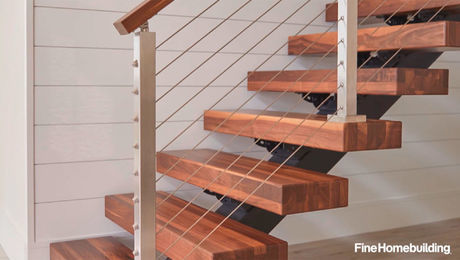What wood working machine can “route” a 4 inch wide by 1/64 inch deep cut into plywood? Is the router the best or can a planer be modified to do the job – looking for speed. The plywood to be worked on would be 6″ wide, 3/8″ deep by 5 foot long.
Discussion Forum
Discussion Forum
Up Next
Video Shorts
Featured Story

The Titan Impact X 440 offers great coverage with minimal overspray.
Featured Video
Builder’s Advocate: An Interview With ViewrailRelated Stories
Highlights
"I have learned so much thanks to the searchable articles on the FHB website. I can confidently say that I expect to be a life-long subscriber." - M.K.
Fine Homebuilding Magazine
- Home Group
- Antique Trader
- Arts & Crafts Homes
- Bank Note Reporter
- Cabin Life
- Cuisine at Home
- Fine Gardening
- Fine Woodworking
- Green Building Advisor
- Garden Gate
- Horticulture
- Keep Craft Alive
- Log Home Living
- Military Trader/Vehicles
- Numismatic News
- Numismaster
- Old Cars Weekly
- Old House Journal
- Period Homes
- Popular Woodworking
- Script
- ShopNotes
- Sports Collectors Digest
- Threads
- Timber Home Living
- Traditional Building
- Woodsmith
- World Coin News
- Writer's Digest


















Replies
Jointer.
Zano,
I think Tom's right. It might pay depending on the job, to pick up a set of inexpensive blades and cut them down to the size you need. Real easy if you have a cut-off saw.
Jon
No need to do that. Just remove the guard, and slide the fence over so the cut is 4" wide. The little ledge on the side of the out feed table is called a rabbeting ledge. It supports the uncut part of the board.
Dave,
My impression was that Zano wanted to cut a groove (vs. a rabbit) 4"wide by 1/64 deep. ie. mtrl. on both sides adjacent to the cut.
I see you are from the Woodstock, NY area. Just a long shot question, but do you know the Fisher's who live up on Mead Mountain Road?
Ah, I must have read his post too fast and missed that part(oops).
Not familiar with anyone by that name, there's so many 'transplants' here, I hardly know anyone any more.
Dave,
Actually, Used to be a friend from HS. Think they've lived there for ~30+ years. Originally used as a weekend home, 5000+ sq. ft. (Dad owned NYC ad agency, had big bucks) Stunning view from inside about 3/4 of they way up the mountain. You could see all the way to the reservoir(Ashoken?), even from the pool cut into the hillside. Haven't seen 'um in 15 years.
Jon
Edited 5/5/2003 7:55:52 PM ET by WorkshopJon
Sorry, but the name still doesn't ring a bell. That doesn't mean that much though, because they could have been good friends that long ago, and I have forgotten. Did/do you live here in the area?
Rather than routing into the lumber, can you build it up? That is, at the edges glue on two strips 1" wide by 1/64" thick? (1/64" thick is close to standard veneer, which is typically 1 /40" thick.)
If you can't conveniently get veneer, try starting with a 4" wide piece of lumber and gluing on 1" wide strips, offsetting the strips your 1/64" from flush. You can do it by putting the 4" piece face-down on a flat bench, but spacing it off the bench by your 1/64"; use business cards or several sheets of Post-it notes for shims. Put the 1" strips flush down on the bench and glue them to the 4" piece.
Edited 5/5/2003 1:01:43 PM ET by JAMIE_BUXTON
Unless there's some hidden consition here, my first thought would be to put the dado blade in the table saw and make several passes.
Phill Giles
The Unionville Woodwright
Unionville, Ontario
Fellas,
Should have mentioned that the 4" groove is in the middle of the 6" wide plywood. If I get a 6" Joiner and dull or grind the blades, one inch on each side, that should do it huh?
Just want it to be the easiest method instead of making multi passes with a dado blade.
Zano, trust me on this: Do you have a table saw ? Even a good portable ? And do you have a dado blade (every woodworker needs a dado blade) ? You didn't say if the dado needs a clean, flat bottom, or just close; the reason I ask is that if you need high-quality, then you need the expensive dado with 2 blades and the chippers, if you just need a "groove, the you could get away with a wobbler or a vee-blade dado.
In any case, that is the simplest, fastest, method; and probably the cheapest in the long run. .
Phill Giles
The Unionville Woodwright
Unionville, Ontario
Is it possible to set a guide on each side and make two passes (one down each side) with a door planer?
TCW Specialists in Custom Remodeling.
Mikita makes a tool called a groove cutter..... think of a skil saw with a big dado head.. the widest bit made is about an inch and a half so you'd have to do several passes. but you can cut those grooves as fast as you can push the tool along.. put a straight edge (I'd use a piece of angle iron) as a guide so everything winds up straight..
it will route up to about 1 5/8ths of an inch deep with the wide one and deeper with the narrower ones.. perfect sides and a smooth bottom..
If it's just like a relief cut, and doesn't need to be very precise, just belt sand it.
Could you tell us where you want to go with this? I mean, a 1/64" dado?
Why, what for, how many pieces, how accurate does it need to be?
I'm thinking of doing something in production work to aid in my work - that's as much I can say now.
-----
Phil,
I know nothing much about woodworking, so I asked. I spoke to one of my favorite GC's, he's got a woodworking shop in his basement, so he said to use a Shaper, which he has, with a special knife. So, he knows of a guy who can make a special knife for about $125.00 and the GC will test it for me.
-----
The Joiner idea I liked, but I checked out some cheap Joiners at the Home Depot and the cheap Delta one has half the table move. Then I saw this better joiner at a woodworking machine outlet and the knives move up and down only up to 1/8". That one may work if I dull the knives 1" on each side.
I was trying to figure out two things.
First, how much you have to do.
Second, how precise the dado has to be, in width and depth.
Have your secrets, sounds like the shaper idea is a keeper. ;-).
Does it have to be plywood?
For the money you are going to spend on a one time knife for someone elses tool, with no guarantee of accurate results (1/64"), especially in plywood, you might consider having a specialty fabricator make up this "prototype" in a different material, such as plexiglas, lexan, etc. It's even possible that a signmaker, one that uses plexi, can do the job. I had some stuff done in plexi and stainless a few years ago and those specialty shops are very good and very accurate.
First, how much you have to do.
Second, how precise the dado has to be, in width and depth
About 20 per day and not that precise; a rough job is OK.
----
Other Fellas,
I'll try a variety of ways of doing this, looks like I'll spend a day at the GC's basement and play with woodworking tools so hopefully this can be done the easiest way. So thanks for all the advise - will try it all ways.
"Rough job"
and
"1/64""
are not twin phrases that I would use in the same sentence..
Excellence is its own reward!
Maybe by 1/64" he just meant "roughly" a RCH, not exactly 0.015625"?If everything seems to be going well, you've obviously overlooked something.
That just one BCH away from being a racist comment, you know. But I know you would never ...
LOL.
Excellence is its own reward!
I didn`t think plywood was even flat enough to get an consistant 1/64 groove into it. If you`re using the jointer, you`ll have to make infeed and outfeed flat (same height) and raise the custom width blades 1/64 above the table height. Otherwise the hensfenkkin will obstrurcurrate the wiffinstaable...
Cutter that wide on my Williams and Hussey Milling machine. ( edit ; it could do twenty in an hour)
The dado head is easiest for some jobs but least accurate for this and impossible for production work.
Shaper OK for a prototype or few pieces but too much skilled manpower for high production..
Excellence is its own reward!
Edited 5/11/2003 10:19:02 PM ET by piffin
you could try a molder or take a thickness planer and set up guides as well as trashing a set of blades to set the width, that way you could just feed and forget.
james
I have a Makita 3 1/4" planer and have done this many times with it. Two passes on each board and you are done. Use this method only if you are using it for the back of a board, not the finish side